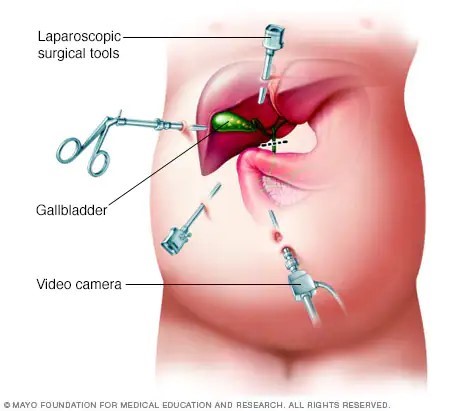A nurse is reinforcing teaching with a client who is postoperative following a laparoscopic cholecystectomy. Which of the following statements by the client indicates an understanding of the teaching?
“I should eat a high-fat diet for several weeks."
"I should expect to have diarrhea until my diet changes."
"I should expect to have nausea for several days."
"I should leave my steri-strips on until they fall off."
The Correct Answer is D
After a laparoscopic cholecystectomy, steri-strips or adhesive strips are commonly placed over the small incisions. The client should keep the steri-strips in place until they fall off on their own or until they are removed by the healthcare provider during a follow-up visit. Removing the steri-strips prematurely can increase the risk of infection or disrupt the healing process.
"I should eat a high-fat diet for several weeks": After a laparoscopic cholecystectomy, it is important for the client to follow a low-fat diet initially to allow the body time to adjust to the absence of the gallbladder. High-fat foods can be more difficult to digest and may cause digestive discomfort. Gradually introducing small amounts of fat back into the diet is recommended, but a high-fat diet is not appropriate.
"I should expect to have diarrhea until my diet changes": While changes in bowel movements can occur after a cholecystectomy, such as looser stools or changes in frequency, persistent diarrhea is not expected or normal. If the client experiences persistent diarrhea, they should contact their healthcare provider for further evaluation.
"I should expect to have nausea for several days": While some clients may experience mild nausea or discomfort after the surgery, it should generally improve within a few days. If the client experiences persistent or severe nausea, they should contact their healthcare provider.

Nursing Test Bank
Naxlex Comprehensive Predictor Exams
Related Questions
Correct Answer is B
Explanation
Veracity refers to the principle of truthfulness and honesty in communication. By truthfully communicating about the adverse effects of the prescribed medications, the nurse is demonstrating veracity. This ethical principle emphasizes the importance of providing accurate information to the client to promote informed decision-making and autonomy.
Justice refers to fairness and equitable treatment, ensuring that individuals receive what they are due and that resources are distributed appropriately. While justice is an important ethical concept in healthcare, it is not directly applicable to the nurse's communication about adverse effects.
Autonomy refers to respecting the right of individuals to make their own decisions and choices regarding their healthcare. While truthfully communicating about adverse effects supports autonomy, autonomy itself is not the specific ethical concept being exhibited in this scenario. Beneficence refers to the ethical principle of acting in the best interest of the client and promoting their well-being. While providing accurate information about adverse effects can be seen as a form of beneficence, it does not directly address the nurse's truthful communication in this specific scenario.
Correct Answer is C
Explanation
Wearing a medical identification wristband is important for children with chronic conditions such as cystic fibrosis. It helps alert others, including healthcare providers, about the child's condition in case of emergencies. The wristband can provide vital information about the child's diagnosis, treatment needs, and emergency contacts, ensuring appropriate care and timely interventions.
The other options mentioned are not appropriate or necessary for the care of a child with cystic fibrosis:
A- It is important to involve the child to an age-appropriate extent in decision-making about their treatment. Encouraging the child to participate in their own care and treatment decisions can promote their independence and self-management skills.
B- The influenza vaccine is generally recommended for children with cystic fibrosis, as they are at increased risk of respiratory infections. The vaccine helps protect against influenza and its potential complications. Therefore, the nurse should emphasize the importance of annual influenza vaccination for the child.
D- Homeschooling may not be necessary solely based on the diagnosis of cystic fibrosis. The decision regarding the child's education should be made based on their individual needs, abilities, and preferences, in consultation with the child's healthcare team and educational professionals.
Whether you are a student looking to ace your exams or a practicing nurse seeking to enhance your expertise , our nursing education contents will empower you with the confidence and competence to make a difference in the lives of patients and become a respected leader in the healthcare field.
Visit Naxlex, invest in your future and unlock endless possibilities with our unparalleled nursing education contents today
Report Wrong Answer on the Current Question
Do you disagree with the answer? If yes, what is your expected answer? Explain.
Kindly be descriptive with the issue you are facing.
